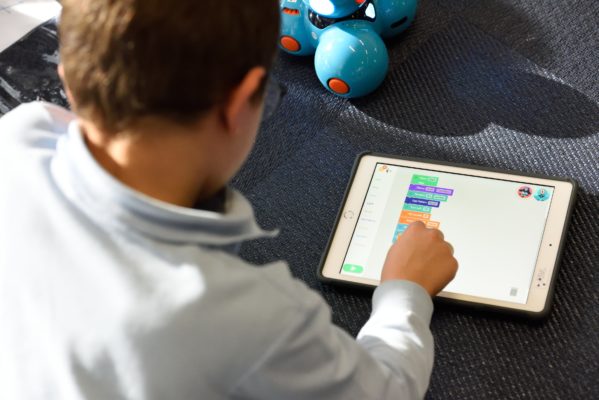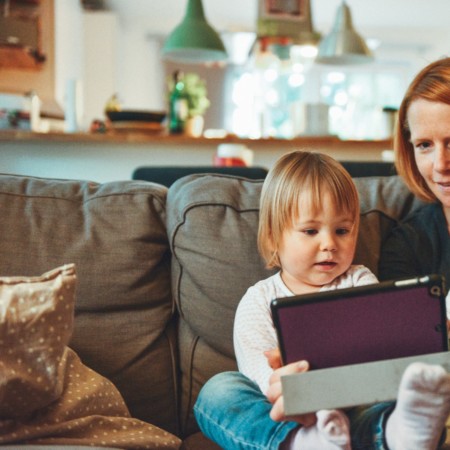Living, as we have, alongside a global pandemic over the last year has meant that most of us, kids included, are spending way more time online than ever before. To be fair, the endless months of social isolation and lockdowns would have been significantly more difficult without access to technology.
We all rely on technology
We have relied on technology to meet so many of our children’s needs (as well as our own of course) – whether it’s home schooling, socialising or entertainment. It is a natural inclination of children to want to socialise with their peers offline and the opportunities to do so in the strictest lockdowns have been so much more limited. This is probably one of the reasons why we’re seeing an increase in children becoming even more active online. The Children’s Mental Health Report (2019) found that 81% of teens surveyed said social media made them feel more connected to their friends. We can imagine that the subsequent lockdowns have only intensified this feeling.
It’s important to acknowledge in any discussion about the role technology plays in our lives, that it adds huge benefit and opportunity. Children have a different relationship to technology than their parents, born as they were into the internet age. They weren’t around in those bygone days that some of us hark back to when kids’ lives were different, when they spent their free time outside, climbing trees and exploring the physical world around them. There were television sets of course but the viewing options were limited and it would have been hard to spend endless hours staring at a screen. No rose-tinted spectacles to see here! (Was it really so wonderful way back when?)
But the world has moved on and in so many ways, pandemic aside, for the better. Children have a wealth of information and opportunity at their fingertips and with the click of a button, they can power up their device. And as I already mentioned, how would we have survived all the lockdowns without allowing them to spend significant periods of their day in front of their screens – even it was just to get schoolwork completed (in the strictest households) and to chat to friends, play online games, watch and post videos on popular platforms like YouTube, TikTok and others.

How much screen time is too much?
And that’s the element of the online world that often gets missed… it offers huge variety. We frequently hear debates about screen time and questions around ‘how much is too much’.
There has been extensive research on the subject and the conclusion is ambiguous: not all screen time is equal. This is an important thing to remember because there can be really constructive, enjoyable aspects to being online, as well as the other, more negative side: the endless scrolling, the FOMO, the hours spent on one particular game that offers little in the way of learning, creativity or skills development.
We need to spend more time thinking about what we (and our children) are doing online and worry less about for how long. Finding the right balance can refer to what we’re doing online as well that vital online/offline balance.
That’s not to say that we don’t need to ensure that we do have a healthy balance between our online and offline lives. Getting enough fresh air, exercise, healthy meals, quality time with loved ones and device-free time are all still essential ingredients of a healthy life. (For some inspo on indoor screen free activities check out our earlier blog post here.)

Whilst this advice applies to all of us, we need to be particularly vigilant with regard to our children because they are more vulnerable to online risks. Many children, isolated from their friends and their normal lives, will be looking for opportunities for social interaction online.
Children are not always discerning about who they are interacting with online and may well have friends and followers that they don’t know: CyberSafeKids’s most recent research (pre-pandemic) shows that 65% of the children we surveyed over the 2019-20 academic year were signed up to social media and instant messaging accounts, and almost a third (30%) of those children had friends and followers on those accounts that they didn’t know offline.
Given that the whole raison d’être of many of these online services is to encourage us to interact with others and to share, then we know that some of these children will be sharing personal information with their followers – their name, where they live and go to school, their likes and dislikes – without understanding the possible consequences of doing so. The possibilities of compromising their identity, privacy and safety are very real.
Top tips for staying safe and healthy online
It remains essential that parents are monitoring their children’s online activity and that they are continuing to engage with their kids about their online lives. Whilst it may not be possible to monitor them at all times, we can equip them with the knowledge and skills to both stay safe and to maximise the opportunities that are available to them online.
Here are a few of our top tips. None of these require you being a technical genius, so there is no excuse.
Regular conversations
Have regular conversations with your children about what they’re seeing and doing online. Let’s face it, we genuinely have more time for this now, so let’s use it. It’s important to talk about the fun stuff as well as the more harmful content they may encounter online. Talk about the fact that people may not always be who they say they are. Talk about being kind both online and offline.
Simple rules
Put in place simple rules around use and access and stick to them (even if these are rules that have been adjusted to the new situation). This could include when, where, for how long they can be on devices, device-free mealtimes, keeping friends/follower lists tight, and agreeing which games they can play as well as ensuring a good balance in online and offline activity.
Stay informed
Keep yourself informed about the apps and games they enjoy using and how to enable privacy-settings and parental controls. A simple online search will often provide a plethora of good info on the dos and don’ts of particular apps – we’d particularly recommend commonsensemedia.org Webwise.ie and (of course) cybersafekids.ie
Stay positive
Keep the focus on the positive as well as balance in all things: there are so many ways to positively engage with technology, whether it’s chatting with friends, getting the 5-minute exercise or dance hit, listening to audiobooks, research, learning, enhancing digital skills – the list is endless so ensure the emphasis is on the positive uses of technology and minimise the less positive time spent online.
Maintain a level of trust
Make sure they know they can ALWAYS come to you with anything they’re not sure about or anything that makes them uncomfortable or scared. This should not be at risk at losing all online privileges since this will reduce the likelihood of them coming to you, so make it an open channel of communication.
Alex Cooney is the Chief Executive Officer of CyberSafeKids
Enjoyed this topic? We’ve got lots more where that came from. Click to read some related articles including ‘How to Keep your kids safe online while they’re gaming’ and our ‘Buying Devices for Kids Guide’.

